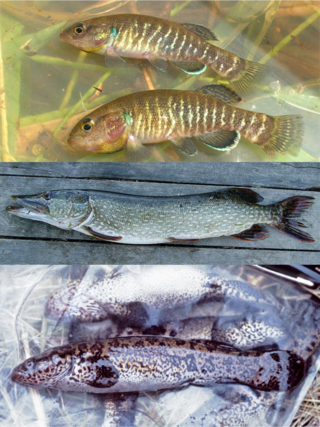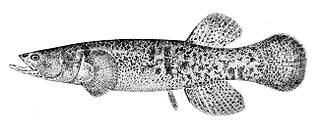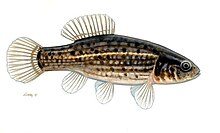
Esocidae is a family of fish in the order Esociformes, which contains pike, pickerel, and mudminnows. While the family traditionally only contained the genus Esox, recent genetic and paleontological research have recovered Novumbra and Dallia as members of the family Esocidae, being closer related to Esox than Umbra. Fossil specimens from the Mesozoic in North America have been assigned as two additional genera in this family.

The Esociformes are a small order of ray-finned fish, with two families, Umbridae and Esocidae. The pikes of genus Esox give the order its name.

Pseudaelurus is a prehistoric cat that lived in Europe, Asia and North America in the Miocene between approximately twenty and eight million years ago. It is considered to be a paraphyletic grade ancestral to living felines and pantherines as well as the extinct machairodonts (saber-tooths), and is a successor to Proailurus. It originated from Eurasia and was the first cat to reach North America, when it entered the continent at about 18.5 Ma ending a 'cat-gap' of 7 million years. The slender proportions of the animal, together with its short, viverrid-like legs, suggest that it may have been an agile climber of trees.

The Anatidae are the biological family of water birds that includes ducks, geese, and swans. The family has a cosmopolitan distribution, occurring on all the world's continents except Antarctica. These birds are adapted for swimming, floating on the water surface, and in some cases diving in at least shallow water. The family contains around 174 species in 43 genera.

Physeteroidea is a superfamily that includes three extant species of whales: the sperm whale, in the genus Physeter, and the pygmy sperm whale and dwarf sperm whale, in the genus Kogia. In the past, these genera have sometimes been united in a single family, the Physeteridae, with the two Kogia species in the subfamily Kogiinae; however, recent practice is to allocate the genus Kogia to its own family, the Kogiidae, leaving the Physeteridae as a monotypic family, although additional fossil representatives of both families are known.

Esox is a genus of freshwater fish commonly known as pike or pickerel. It is the type genus of the family Esocidae. The type species of the genus is Esox lucius, the northern pike.

Carcharodon is a genus of sharks within the family Lamnidae, colloquially called the "white sharks." The only extant member is the great white shark. The extant species was preceded by a number of fossil (extinct) species including C. hubbelli and C. hastalis. The first appearance of the genus may have been as early as the Early Miocene or Late Oligocene.

Crestfishes, family Lophotidae, are lampriform fishes found in most oceans. It consists of two extant and four extinct genera.

Novumbra is a genus of mudminnows native to Oregon and Washington state, USA. Molecular data suggests that this genus is more closely related to Esox than Dallia and Umbra. Novumbra diverged from Esox roughly 65 million years ago in the Paleocene.

The European mudminnow is a species of fish in the Umbridae family found in Austria, Bosnia and Herzegovina, Bulgaria, Croatia, the Czech Republic, Hungary, Moldova, Romania, Serbia, Montenegro, Slovakia, Slovenia, and Ukraine.

The central mudminnow is a small fish in the family Umbridae of the order Esociformes. It is found in central and eastern North America in productive waters. It is fairly tolerant of low oxygen concentrations and, as a result, it is sometimes the only, or one of a very few, fish species present in waters susceptible to winter or summer kill.

The eastern mudminnow is a species of freshwater fish belonging to the family Umbridae. It is native to eastern North America, but has been introduced to Europe. It feeds primarily on insect larvae and other small aquatic invertebrates.

Caranx is a genus of tropical to subtropical marine fishes in the jack family Carangidae, commonly known as jacks, trevallies and kingfishes. They are moderate- to large-sized, deep-bodied fishes which are distinguished from other carangid genera by specific gill raker, fin ray and dentition characteristics. The genus is represented in the Pacific, Indian and Atlantic Oceans, inhabiting both inshore and offshore regions, ranging from estuaries and bays to deep reefs and offshore islands. All species are powerful predators, taking a variety of fish, crustaceans and cephalopods, while they in turn are prey to larger pelagic fishes and sharks. A number of fish in the genus have a reputation as powerful gamefish and are highly sought by anglers. They often make up high amounts of the catch in various fisheries, but are generally considered poor to fair table fishes.

Ichthyosaura is a genus of newts in the family Salamandridae, found in Europe. It contains one extant species: the alpine newt. One fossil species from the Miocene, Ichthyosaura randeckensis, has also been referred to this genus, although this has been challenged.

Umbra is a genus of mudminnows native to Europe and North America.

Dallia is a genus of mudminnows native to Russia and Alaska. Molecular data indicates the genus is more closely related to Esox and Novumbra than Umbra.Dallia diverged from Novumbra + Esox approximately 66 million years ago.
This list of fossil fishes described in 2015 is a list of new taxa of jawless vertebrates, placoderms, acanthodians, fossil cartilaginous fishes, bony fishes and other fishes of every kind that have been described during the year 2015, as well as other significant discoveries and events related to paleontology of fishes that occurred in the year 2015. The list only includes taxa at the level of genus or species.

Titanochelon is an extinct genus of giant tortoises known from the Early Miocene to the beginning of the Pleistocene in Europe, extending from the Iberian Peninsula to Anatolia. Some members of the genus were larger than extant giant tortoises, with a shell length of up to 2 m.

















